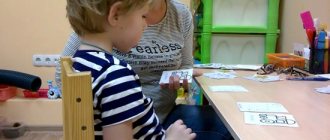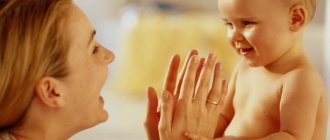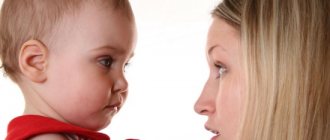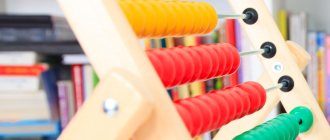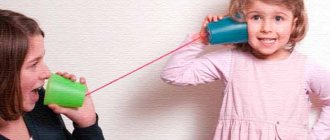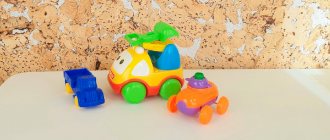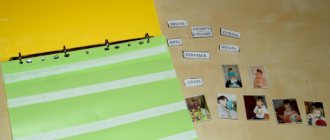What kind of speech is there, you will say, if from him you can only hear a loud “ooh!”, and in moments of calm and blissful mood - “aha” and “aha”, not counting other indistinct and unintelligible sounds. Many parents believe that before their child utters his first words (and this usually happens at the age of about a year), it is useless to talk to him, since he, they say, still does not understand anything and cannot yet learn anything.
However, “unintelligible sounds” are already the formation of speech, and it begins long before the appearance of the first words. And already at this very first stage, the main function of speech is clearly visible - communication. Yes, yes, your baby can and wants to communicate with you!
In order to imagine how to communicate with a baby, let's look at the main stages of speech formation.
The first stage is screaming
When a baby is born, coming from one environment to another, he needs to somehow declare himself, his presence in this world. While the child was in the mother's belly, all his needs were satisfied instantly. Now he sometimes feels some kind of discomfort - and screams (still at the level of an unconditioned reflex). When the baby's needs are met, the child develops a certain behavioral stereotype, and the cry becomes a signal of discomfort (wet, wants to eat or sleep, sad, lonely). The child has only one remedy - screaming. Gradually, with the help of a cry, the baby learns not only to attract attention to himself, but also to communicate. Remember, when your baby calls you, he first screams and then waits for an answer: will mommy come or not? Then he screams louder and waits again. In this way, the child gives his “interlocutor” the opportunity to engage in his first dialogue.
Photo: nastyaofly / freepik.com
Around the third month (and for many babies much earlier), the intonation of screams also changes. An attentive mother can identify many different cries of her child - it could be grumbling, whining, dissatisfaction, a sharp squeal of pain, angry “exclamations”.
“Even if I’m in another room, I can almost certainly tell from the screams what’s happening to my twins. When they quarrel and cannot share toys, the cry is the same; when they are bored, the cry is completely different. And, of course, I always distinguish shrill and sharp “dangerous screams” (when you urgently need to run to help) from “non-dangerous” ones, when children simply express their dissatisfaction.”
The cry is present in the child for quite a long time, developing in parallel with speech. And even when real, “adult” words appear, screaming continues to play a very important role in communication.
Second stage - humming
Buzzing usually occurs at the age of one to two months and accompanies the child in the first six months of life. Usually these are different variations of sounds: a-a-gu, gee-s, ge-e, a-gy, etc. It is curious that babies of different nations walk in the same way. Gradually, the baby’s repertoire is enriched with new sounds, and new intonations appear. In humming, as in shouting, the moment of interaction is also important. Of course, the baby can go for a walk even when left alone in the room. But with your appearance, the partying becomes more active. If you look closely at the child, you will see that he does not just make sounds. At this time, the baby looks into your eyes, waits for your answer, he is already trying to build a full-fledged speech dialogue. And this dialogue must be supported! After all, while walking, the child learns to coordinate both his voice and his gaze, which will subsequently become the basis of any social contact.
The baby seeks your attention and communication using the method of carrot and stick, as ancient as the world, only instead of a stick he uses crying, and instead of a carrot - his charming and joyful smile.
Photo: mimagephotography / freepik.com
Answer your child in his language, support and encourage his first “performances” in every possible way. He will be very pleased with your attention - look how he reaches out to you, tries to purse his lips in order to adequately answer such an important interlocutor! Gradually, the child begins to pronounce long chains of sounds, as if imitating himself. Moreover, he is trying to imitate you too!
A baby at this age is trying to feel sounds and words for the first time. For now, what is important for him is not so much the meaning of words, but rather the different intonations, the rhythm of speech, and the articulation of various sounds.
“My daughter, at the age of four months, began to feel my lips with her hands whenever I said something to her. It seems that she wants to check how different sounds are made, and is trying to catch the words flying out, contrary to the well-known proverb about the word and the sparrow. As soon as there is a pause in my speeches, the baby immediately begins to actively answer me.”
Varieties of humming
In pediatrics and speech therapy, it is customary to distinguish two types of humming:
- hooting (is the initial stage of hooting, when the baby begins to pronounce short monosyllabic structures);
- pipe (the second stage of development of humming, in which the ability to stretch several syllables in a cascade appears; develops by the 4th month of life).
There is no interethnic or international distinction in humming - children from any linguistic and ethnic background hum the same. Only at the final stage of development of this type of communication (closer to six months of life) can features characteristic of a particular people appear in pronunciation.
Buzzing is also typical for children who are hard of hearing or deaf.
Third stage - babbling
As the child develops, the humming subsides and is replaced by babbling. This usually occurs at the age of 6-7 months. Your baby begins to pronounce individual syllables “ba”, “ma”, “ta”, etc. - at first once, very rarely and as if by accident. Gradually, syllables are heard in his speech more and more often, they are repeated in the form of chains: ba-ba-ba-ba, ma-ma-ma-ma.
Booming and babbling are very important for the further development of speech. If your baby doesn’t have them, try to activate them.
Photo: dusanpetkovic / freepik.com
Holding the baby in your arms so that he can clearly see the movement of your lips, repeat various syllables, sing rhythmic songs, read simple rhymes, and most importantly, talk to the baby as much as possible. He needs to hear adult speech. However, these should not just be conversations that adults have with each other, but speech addressed specifically to him, to the child.
“My son is now 6 months old. He distinguishes different voices by ear. If I talk to him, hiding behind the diaper, he starts smiling joyfully and looking for where his mother has gone. And one day he heard the voice of someone else’s uncle from the hallway - it was a thick bass voice, completely different from his father’s voice - he heard it and began to cry loudly.”
“My ten-month-old Dashunya loves to “read” books - most of all traditional Russian fairy tales for little ones, “Kolobok”, “Turnip”, “Ryaba Hen”. She also really likes conversations on the topic: who talks how. The variations are endless – from a pussy to a big-ass truck or a steam locomotive.”
Again, even if it seems to you that the child is babbling to himself, nevertheless he is very eager to communicate with you. The first babbling words-syllables do not yet carry any meaningful meaning. But it is thanks to the mother, who hears the words in these syllables, that the babbling is filled with meaning.
“Surprisingly, Fedya began to speak the syllables “ma-ma” from the first days. Of course, at first he cried so much. But gradually, he realized that his “mama” especially touches me, especially since everyone said around him that he was calling his mother.
By six months, this “mama” began to mean not “come to me,” but “give me MOMMY here.” At eight months old, he clearly addressed me, and called me while in the arms of others, and there was no doubt that this was already a real word.”
What does Dr. E. Komarovsky think about this?
We also recommend watching another video about at what age, as a rule, babies begin to coo:
The baby's humming and cooing are rapidly changing stages of development. To prevent these processes from becoming a disappointment for mothers and fathers, it is necessary to prepare from birth, wait for the baby’s first sounds and prepare the child for this. Simple exercises will push the baby to the first walk and “aha”. But the most important thing is to maintain emotional calm within the family and give the baby all the love and tenderness.
Lesson or communication?
Of course, when communicating with a child, we teach him one way or another. But try not to let your desire to teach your baby literally from the cradle overshadow a more important thing - your live emotional communication.
Photo: ShevtsovaYuliya / freepik.com
If you follow the theories of early development, you probably heard the name of the American scientist Glen Doman, who argued that, being in a special learning environment from a very early age, a child can achieve very high intellectual results. At his Institute of Child Development, Doman conducted many experiments, the essence of which boiled down to the following. Beginning at two months of age, when their eyes begin to focus, infants were rapidly shown various cards depicting letters, words, notes, numbers, pictures, hieroglyphs and much, much more. During the demonstration, the teacher or mother named the corresponding object. At first, such “lessons” lasted 5-10 minutes, then their duration gradually increased.
When the kids grew up, this is what became clear. They really remembered information perfectly, spoke foreign languages, read, counted, etc. But at the same time, the kids did not play at all; their emotional sphere was disturbed. Accustomed to only passively absorbing didactic material, they did not strive for active knowledge of the world around them; creativity was inaccessible to them, since they had no real creative experience. And they could not always put into practice that huge store of knowledge that their tenacious childhood memory stored. The saddest thing is that the emotional disturbances in these children were already irreparable. After all, many very important milestones of emotional development are laid precisely in infancy, when the child wants and can communicate, build social models of behavior, and not record countless dry facts in his brain.
In my psychological practice there was a boy, Andryusha, who could not adequately communicate with his peers. He ran in circles, constantly repeating the same phrase. At the same time, he had very big problems with the articulation of sounds: at the age of five he simply could not pronounce about fourteen sounds, so it was difficult to understand him. He preferred to communicate in writing.
It turned out that Andryushin’s mother was at one time very interested in the early intellectual development of her son. As a result, he learned to read before he spoke. At the same time, he did not play, studying numbers, letters, special cards, and only drew geographical maps.
When starting to teach your child letters in infancy using a newfangled developmental method, be careful! Some children who were taught to read, for example, using Zaitsev's cubes before they began to speak, had delayed speech development. Instead of engaging in live communication, they read and wrote using blocks.
Stage four - first words
So, from babbling a word is born...
At this stage (usually it begins at 11-12 months) it is very important to help the child with his word creation. It is now that the baby begins to associate words with objects in the environment, words are filled with meaning for him. Now you can expand your reading aloud repertoire. Try to call things around you by their proper names (not “Let’s put this thing in there”, but “Let’s put the doll in the crib”). Don't forget to comment on your actions when you are with your baby.
Speech therapists advise training the muscles of the lips and cheeks. To do this, stock up on various whistles, harmonicas, and a toy flute and teach your child how to blow on these instruments. It is also useful to blow soap bubbles (although you will have to constantly make sure that the child does not drink the soap solution).
Another fun way to exercise your lip and cheek muscles is to make faces with your baby. Feel free to make funny faces, expressively depict a variety of emotions (surprise, fear, joy), stick out your tongue, lick your lips. You will see that your baby will really like this new game, and soon he will begin to repeat some movements after you.
Children usually really like sounding toys. Take advantage of this and let your baby learn to make a variety of sounds and reproduce them with his voice. His first words will be onomatopoeic: “bang”, “boom”, “woof-woof”, “bibika”. Don’t be afraid of these infantile, “Lala” (as my eldest daughter says) words. This is a very important moment in speech development. It is still difficult for a child to associate an abstract word (for example, dog, car, fell) with a specific object or action. If the word is at least somewhat similar to an object or action, such a connection will be much easier to establish (for example, a dog says “av-av”, a car says “beep”, and a falling object makes “boom”). Infant words help the child transition to normal, “adult” speech.
When your baby tries to repeat some words after you, you can read the poems “by role.” For example, the famous poem about desperate geese (everyone, as a rule, remembers its beginning):
- Adult: Geese, geese!
- Child: Ha-ha-ha!
- Adult: Do you want something to eat?
- Child: Yes, yes, yes!
- Adult: Bread and butter?
- Child: No, no, no.
- Adult: What do you want?
- Child: Candy!
- Adult: Well, fly as you want, just take care of your wings - the gray wolf under the mountain won’t let you go home. They flew and flew (the child waves his arms) and sat on his head.
When you read well-known poems or sing songs to your baby, pause at the end of the line so that the child can finish the line himself.
It is especially important to talk to your baby while playing. Do not forget that the game is focused specifically on dialogue, and not on your monologue. You can, for example, roll a ball to each other, accompanying this activity with comments: “Give me the ball! The ball rolled towards mom.” Pause and give your child the opportunity to join the conversation. “And now - on the ball! The ball rolled towards the baby,” etc. Try to match the game to your baby’s mood and state.
Child development in the first three months of life
Every parent wants to know what their child will be like. Mothers often ask the question: “When will my baby hold his head up?”, “What does he see now?” We invite you to talk about this. In this article we will discuss the development of a child from birth to three months.
There is no clear opinion about the timing of newborn birth. Most opinions agree that the neonatal period lasts 28 days, but some authors believe that this period ends only at the beginning of the second month of life. And it gives way to the period of infancy. [3]
A newborn baby is very different from an adult in many ways. The baby's head is large relative to the body, and the arms and legs, on the contrary, are short. If you touch the head, you can find fontanelles - large, small and lateral. The muscles are underdeveloped, the skin is thin and delicate. After birth, the child strives to take the intrauterine position, curl up, bend his arms and legs and pull them towards the body. Babies have pronounced hypertonicity, so it can be quite difficult to straighten the baby. At birth, the nervous system and brain are formed, but immature.
A child is born completely dependent and completely dependent on an adult.
The behavior of a newborn is based primarily on reflexes.
These are reflexes that ensure the functioning of the main systems of the body - breathing, blood circulation, digestion, etc.
In addition, we can distinguish such important unconditioned reflexes as:
1. Food and labyrinth concentration. Food concentration appears in the form of sucking, labyrinthine concentration occurs during motion sickness. These are some of the strongest reflexes. [3] That is, to calm the baby down, you can simply put him on the mother’s breast and rock him.
2. Food reflexes: searching, sucking, swallowing. Try to touch the corners of the baby's lips, his cheeks and you will see how he begins to look for the breast, stretching out his lips, and then grabs the nipple and begins to make sucking movements.
3. Protective, defensive reflexes. These include the Paper reflex or pupillary reflex - to a bright light or a clap above the head, the child closes his eyes or turns his head towards the light, sound, as well as the Moro reflex - if the child’s head is given some acceleration, for example, lightly hitting the pillow under the head, then the child quickly spreads his arms to the sides and spreads his fingers. In addition, every newborn baby withdraws its limbs to painful stimuli. [6]
4. Approximate reflexes from the visual and auditory analyzers - vision and hearing. [3]
5. Reflexes-atavisms. These include the atavistic monkey reflex or the grasping reflex, the Robinson reflex. Push-off reflex (if you put a support, for example, a book, on the baby’s legs, he can crawl a little), walking, swimming reflexes. For example, in the first 3 weeks, if you take a baby under the arms, he makes walking movements, and if you put him in water on his tummy, he makes swimming movements. By 3 months they disappear. [3] The breath-holding reflex, for example, is used in the practice of early childhood swimming instructors.
In addition to these reflexes, there are many others that control the behavior of a newborn. Unconditioned reflexes are not fixed in the child’s behavior; they gradually fade away. They are replaced by conditioned reflexes. [5] Parents can notice the first conditioned reflexes already on the 9th day of the child’s life. For example, a reflex to the position under the chest. [6]
The most developed sensitivity in a child immediately after birth is skin sensitivity. It reacts to touch and temperature differences. The most sensitive areas are the child's lips, palms and forehead. A newborn baby also has sufficiently developed taste and olfactory sensitivity. Vision and hearing are immature at the time of birth. In the first days after birth, the baby may not respond even to loud sounds. However, already at 2-3 weeks of a child’s life, the first reactions to sound can be noticed. The baby seems to freeze at a loud sound. At 3-4 weeks, the same reaction occurs to the human voice. And already at 2 months of life, the child develops the ability to distinguish the human voice from all sounds. For example, a mother’s gentle voice has a calming effect on the baby. [5]
A newborn's vision is poorly developed. Intensive development occurs just after birth.
After 6 days of life, the child begins to follow moving objects. Already in the first or second week, he can turn his head behind a slowly moving object that is located at a distance of 20-30 cm from the baby. This is exactly the distance that allows him to examine and study the mother’s face during breastfeeding. At 2-3 weeks, children begin to try to look closely at objects. At 3-5 weeks the baby freezes and fixes his gaze on an object. From 4 weeks, a child can follow an object at a distance of 1-1.5 m, and by 2 months - at a distance of 2-4 m. [6] The child distinguishes colors very poorly. There are studies that say that children respond more to orange, white, red and green. As the child grows, vision develops and improves [3] The movements of the newborn are chaotic. The development of sensory organs is ahead of motor skills. For example, at the age of 1 month, if the baby is placed on his stomach, he can raise his chin. By 2 months, he tries to raise his head, holds it, and tries to lift his chest. [3] Children, acquiring a new skill, try to develop it, trying to repeat it again and again.
We are often asked: do newborn children have emotions? Of course there is! With the help of emotions, the child communicates with the outside world.
The baby quite often finds himself in a state of discomfort - it can be anything: changing a diaper; Mom did not immediately react to the concern and did not immediately take her in her arms or put her to her breast; getting ready for a walk; cleaning the nose, etc. And the child reacts to any discomfort by crying. Negative emotions predominate in the first month of life. [5] They can also accompany a growth spurt and an age crisis.
However, already in the first hours after birth, you can see some semblance of a smile in the child. It appears both in dreams and during waking hours. Smiling may appear in the first week of life. But the first smiles are usually just a grimace. But already at the beginning of 2 months, the baby appears a real smile, addressed to an adult.
A smile entails a whole complex of revitalization. The appearance of a smile can be called an important stage in the development of the baby. With the “revitalization complex,” muscle hypertonicity decreases. The adhesive unconditioned reflex disappears. The revitalization complex is not only a smile, but also movements of the whole body, increased breathing, vocal reactions, and blinking. [3] Many scientists call the “revitalization complex” behavior, because the child highlights his face and rejoices, all his behavior is aimed at communication. [4]
It is the appearance of the “revitalization complex” that many scientists consider to be the boundary that determines the onset of infancy, which lasts up to one year.
L.S. Vygotsky writes about it this way: “We are the unity of mother and child” [2] This means that the baby itself is helpless. All the child's needs are met by adults.
Separately, I would like to consider the issue of newborn sleep, which is of great concern to many parents. L.S. Vygotsky writes: “A newborn’s sleep is superficial, intermittent, and restless. In his sleep, he makes many impulsive movements, sometimes even eating without waking up. Can sleep with eyes half closed. Sleeps approximately 80% of the day, and an adult – 20%. The general state is a drowsy state with short-term sleep and short-term wakefulness.” [1] Indeed, often in our practice we often see children who do not sleep for long on their own. Sleep without mom is disturbing and intermittent. But at the breast or in the arms of the mother, sleep becomes stronger and longer. Newborns are characterized by short periods of wakefulness followed by short periods of sleep. It has also been observed that babies rest well while sucking on the breast. Combining feeding and rest is an excellent option for both the baby and the mother. It is impossible to spoil a child at this age with your hands; in fact, the period of pregnancy continues for him. In addition, for many parents, the solution is to co-sleep with the child. You can read more about newborn sleep in this article or talk to a sleep consultant in person.
Development of objective actions in infancy
| Age | Sensory and motor acts |
| 1 month | Short-term visual fixation and tracking; auditory concentration; cessation or change in the nature of crying in response to the voice of an adult |
| 2 months | Tracking a toy moving in a horizontal plane; auditory concentration |
| 3 months | Smoothly follows the toy in all directions; turning the head and eyes towards the sound source; points the hand towards the object |
Development of the motor sphere in the first year of life
| Age | Motor functions |
| 1 month | Lying on stomach – briefly raises head |
| 2 months | Lying on stomach - holds head, in vertical position - not constant |
| 3 months | Lying on your stomach - rests on your forearms bent at an acute angle; holds your head well in an upright position |
Development of communication and speech in the first year of life
| Age | Development of communication with adults in the first year of life | Voice reactions |
| 1 month | Wakes up hungry and wet; falls asleep quickly; oral attention when communicating | The cry is loud, clear, with a short inhalation and an extended exhalation |
| 2 months | Clear rhythm of sleep and wakefulness; well-fed and dry does not fall asleep immediately, calm wakefulness; smile when communicating with an adult | The cry is intonationally expressive; initial hum |
| 3 months | Active wakefulness; communication revitalization complex | Scream with distinct intonations; singing hum. Sounds of joy and laughter appear. |
Alena Korotkova, clinical psychologist, lactation consultant
Literature:
- Vygotsky, L. S. Infancy. 1. The newborn period L. S. Vygotsky // Vygotsky, L. S. Psychology / L. S. Vygotsky. – M., 2002. – P. 901-909.
- Vygotsky, L. S. Infancy. 2. Social situation of development in infancy / L. S. Vygotsky // Vygotsky, L. S. Psychology / L. S. Vygotsky. – M., 2002. – P. 919-920.
- Kruchinin V.A. Developmental psychology and age psychology [Text]: textbook. village for universities / V.A. Kruchinin, N.F. Komarova; Nizhegorsk state architecture - builds univ. – N. Novgorod: NNGASU, 2016. – 219 p. I
- Lisina, M. I. Communication with adults in children of the first seven years of life / M. I. Lisina // Developmental Psychology: a reader. – St. Petersburg, 2001. – P. 158-159.
- Obukhova, L. F. Age psychology: textbook. for universities / L. V. Obukhova. – M.: Higher. education ; MGPPU, 2006. – 460 s.
- Shapovalenko, I.V. Developmental psychology: (developmental psychology and developmental psychology): textbook. for university students studying in the field and specialties of psychology / I. V. Shapovalenko. – M.: Gardariki, 2005. – 349 p. (any edition is possible).
Words and gestures
Facial expressions, gestures, and intonation help a person communicate with other people. Please note that adults, when talking to each other, convey a lot of information using facial expressions and gestures (this is why many people find it difficult to communicate on the phone, although they can easily carry on a conversation during a personal meeting). But for young children, non-verbal communication is even more important because at a certain stage it is the only way for them to “talk” to you.
Photo: tatyanadobrikova / freepik.com
It is very useful to reinforce words with certain gestures. First, the baby learns to reproduce the gesture, and then repeats the word. For example, the word “give!” usually accompanied by the following gesture: extend your hand with your palm up and bend and straighten your fingers several times. At the same time, try to use the words “give”, “bring”, “take” more often, ask the child to fulfill simple requests. You will see that he will be very happy to help you!
In a similar way, you can teach your baby other expressive gestures, for example, “Okay”, “Goodbye”, “Show how big (or big) you are”, shake your head affirmatively or negatively. Don’t be shy about children’s gestures, such as pointing with your finger, but rather, help your child master them.
Gestures can also have an emotional connotation.
“Olezhka recently learned to show how sour a tomato is and how sweet a raspberry is. When you ask him: “Which tomato?”, he wrinkles his nose hilariously, showing his disgust for his least favorite food. To the question: “What kind of raspberry?” the child breaks into a blissful smile and smacks his tongue. Of course, at some point we taught him this, but now he often imitates some kind of taste even without our asking. For example, if you say that lemon is sour, Olezhka will certainly frown.”
“Marusa was shown that you can smell flowers. Now, at the sight of any flower (in a flowerbed, in a pot, or even in a book), she reaches out to it with her nose and sniffs it in ecstasy.”
The child can use gestures to accompany your reading of poetry or singing.
For example, like this:
- I play the violin - tili-li, tili-li, (the baby holds an imaginary violin in his hands and “plays” it),
- The bunnies are dancing on the lawn - tili-li and tili-li (“dancing”, twirling their raised arms).
- And then on the drum - bam-bam-bam, bam-bam-bam (the child taps his palms on some surface),
- In fear, the bunnies ran into the bushes! (hides his face in his hands).
Or like this:
- A clubfooted bear is walking through the forest (the child is swaying, legs spread wide),
- He collects cones and sings songs (bends over an imaginary cone).
- Suddenly a cone fell right on the bear’s forehead (slaps himself on the forehead).
- The bear got angry and stomped his foot (the baby stomps his foot).
Or like this:
- Little bunny, dance, little gray one, dance. Dance like this, dance like this, dance like this (the child “dances”).
- Little bunny, stomp your foot, little gray one, stomp your foot, stomp your foot like this and that, stomp your foot like this (stomps first with one foot and then with the other).
- Little bunny, clap your hands, little gray one, clap your hands, clap your hands like this, clap your hands like this (baby claps your hands).
- Bunny, bow, little gray one, bow, bow like this, bow like this (bows).
You can also play “Toys” by Agnia Barto. The kid shows how the bull swings on a shaky board, how the girl Tanya cries bitterly, pities and strokes the poor bear with a torn paw.
By the way, the famous finger games simultaneously train the child’s “speaking gestures” and fine motor skills, which are also very useful for speech development.
Here, for example, is the game “Cabbage”:
- We have cabbage, here it is, cabbage (we show how big cabbage is),
- We cut the cabbage, cut it (with the edge of our palm, like a knife, we knock on the table),
- We three, three, cabbage (rubbing our palms),
- we mash the cabbage, mash it (we pretend to mash the cabbage with our fists).
And here is a finger massage game similar to the famous “Soroka-Soroka” - Pancake Machines:
- Masha began to call guests (we stroke the baby’s open palm):
- And Ivan, come, and Stepan, come, and Andrey, come, and Sergey, come, (we bend our fingers one by one, starting with the thumb),
- And Nikitushka - well, please! (we bend the little finger after stroking it).
- Masha began to treat the guests: pancake to Ivan, and pancake to Stepan, and pancake to Andrey, and pancake to Sergei (we straighten our fingers, kneading the pads - “we hand out pancakes”),
- and Nikitushka - mint gingerbread! (extend the little finger, also stroking it first).
- Masha began to see off the guests: Ivan, goodbye, and Stepan, goodbye, Andrey, goodbye, and Sergei, goodbye! (each finger bends and straightens in turn - as in the “goodbye” gesture),
- and Nikitushka - well, stay a little longer! (we stroke the little finger affectionately).
These games will help your child enrich their vocabulary and relate words to very specific actions or objects.
About over-salted porridge
Remember the famous joke about the boy who didn’t say anything until he was five years old? No medical luminaries and the most famous speech therapists could help him. But one day at breakfast the boy suddenly said: “The porridge is too salty today!” The happy parents rushed to congratulate each other, and when they calmed down, they asked their offspring: “Why were you silent before?” To this the boy replied: “And before everything was fine.”
Jokes aside, when parents understand a child too well without words, he simply does not need to convey any message to them. Perhaps here you sometimes have to be a little cunning, pretending that you do not understand what the child wants from you until he tries to tell you about it.
Until she was two years old, Alina said nothing but “yes” and “no.” I was already starting to worry about this, and suddenly I caught myself formulating all the questions to her in such a way that they could be answered unequivocally “yes” or “no.” When I began to ask more complex questions, as if not understanding my daughter, she came up with many more new words.
If a child communicates with you using babble and gestures, his first words are about to appear. Don't worry if this happens a little later than you think it should. Don't compare your baby to the girl next door, your friend's son, or your coworker's niece! The development of each individual child may have its own individual characteristics.
However, there are some important milestones in your baby's speech development that are worth paying special attention to:
- A cry that is initially a reaction to discomfort (hunger). A child who is too quiet and as comfortable as possible is not as good as it seems.
- Animation complex (smile, animation) when an adult appears (appears at 1-3 months).
- Booming. How and when does your baby roar? Does he look into your eyes at the same time, does he “sing” his baby songs while in your arms, do you feel his need for communication?
- Babbling (appears at 6-10 months), the child clearly attracts attention to himself with the help of some sounds.
- Pointing gesture (appears at 8-13 months). This is a very important moment in the development of a child, preceding the appearance of the first words, because before naming an object, the baby needs to learn how to show it.
- Emergence of basic social gestures, such as “goodbye” (9–12 months).
- Understanding and fulfilling simple requests, the appearance of elementary plot games (feed the doll). A child usually goes through this stage at about one year of age.
Inessa Smyk, Daria Golubeva
Based on materials from the magazine “Aistenok”, 03.04
What to do if your child stops walking
The sudden cessation of humming, if it has not turned into babbling, should cause concern among parents. It is better to show the baby to a specialist in such a situation to exclude the possibility of developmental deviations. This is especially true if the baby not only stopped walking, but also became lethargic and restless.
Parents can help on their own by continuing to talk to the child (expressively, emotionally, actively), copying the sounds of humming and hooting even if the baby no longer voluntarily pronounces them. You must always maintain a favorable psychological environment around the baby. This helps if the condition is not caused by intellectual or physical impairments.
Every parent of a baby should know what humming is, since this is an important process in the development of children's speech, during which the process of learning the correct pronunciation of individual vowels and sometimes consonant sounds occurs. Appears at the age of 2-3 months. You should consult a specialist if the child is lethargic, sad, has suddenly stopped humming, or was initially absent by the age of 7 months. But if the baby is cheerful, cheerful, and also active, it is most likely that the humming has not yet begun due to individual developmental characteristics.
Sources
- Wu Y., Li G., Zheng Y. . // Lin Chung Er Bi Yan Hou Tou Jing Wai Ke Za Zhi - 2022 - Vol35 - N4 - p.341-345; PMID:33794634
- Karcher NR., Loewy RL., Savill M., Avenevoli S., Huber RS., Simon TJ., Leckliter IN., Sher KJ., Barch DM. Replication of Associations With Psychotic-Like Experiences in Middle Childhood From the Adolescent Brain Cognitive Development (ABCD) Study. // Schizophr Bull Open - 2022 - Vol1 - N1 - p.sgaa009; PMID:32803159
- Skovlund E., Selmer R., Skurtveit S., Brandlistuen RE., Handal M. In utero exposure to analgesic opioids and language development in 5-year old children. // Pharmacoepidemiol Drug Saf - 2022 - Vol29 - N6 - p.736-744; PMID:32383248
- Yi YG., Lee DW., Kim J., Jang JH., Lee SM., Jang DH. Two Novel Mutations (c.883-4_890del and c.1684C>G) of WDR62 Gene Associated With Autosomal Recessive Primary Microcephaly: A Case Report. // Front Pediatr - 2022 - Vol7 - NNULL - p.457; PMID:31788460
- Llaci L., Ramsey K., Belnap N., Claasen AM., Balak CD., Szelinger S., Jepsen WM., Siniard AL., Richholt R., Izat T., Naymik M., De Both M., Piras IS., Craig DW., Huentelman MJ., Narayanan V., Schrauwen I., Rangasamy S. Compound heterozygous mutations in SNAP29 is associated with Pelizaeus-Merzbacher-like disorder (PMLD). // Hum Genet - 2022 - Vol138 - N11-12 - p.1409-1417; PMID:31748968
- Wu Y., Li G., Ma Y., Zheng Y. . // Lin Chung Er Bi Yan Hou Tou Jing Wai Ke Za Zhi - 2022 - Vol33 - N10 - p.918-922; PMID:31623034
- Botticelli S., Küseler A., Mølsted K., Andersen HS., Boers M., Shoeps A., Emborg BK., Kisling-Møller M., Pedersen TK., Andersen M., Willadsen E. Influence of Infant Cleft Dimensions on Velopharyngeal Function in 5-Year-Old Danish Children Born With Unilateral Cleft Lip and Palate. // Cleft Palate Craniofac J - 2020 - Vol57 - N4 - p.420-429; PMID:31505955
- Salvago P., Gorgone E., Giaimo S., Battaglia E., Dispenza F., Ferrara S., Martines F. Is there an association between age at first words and speech sound disorders among 4- to 5-year-old children ? An epidemiological cross-sectional study based on parental reports. // Int J Pediatr Otorhinolaryngol - 2022 - Vol126 - NNULL - p.109602; PMID:31374388
- Ingram SB., Reed VA., Powell TW. Vowel Duration Discrimination of Children With Childhood Apraxia of Speech: A Preliminary Study. // Am J Speech Lang Pathol - 2022 - Vol28 - N2S - p.857-874; PMID:31306605
- Dawes E., Leitão S., Claessen M., Lingoh C. Oral literal and inferential narrative comprehension in young typically developing children and children with developmental language disorder. // Int J Speech Lang Pathol - 2022 - Vol21 - N3 - p.275-285; PMID:31159597
